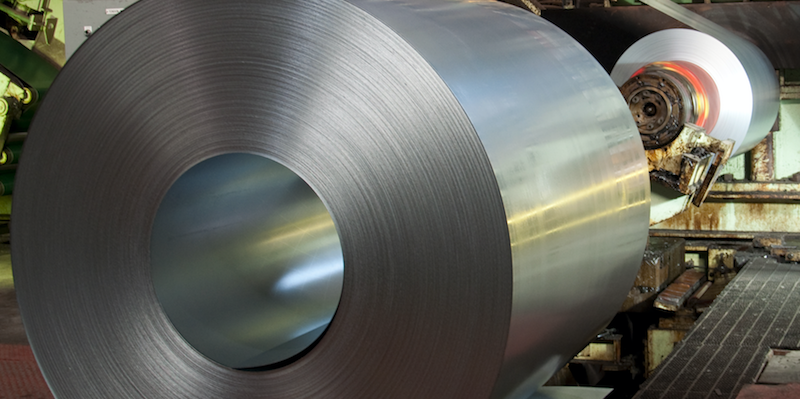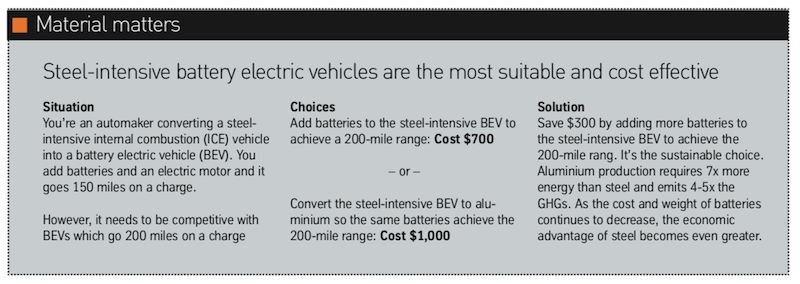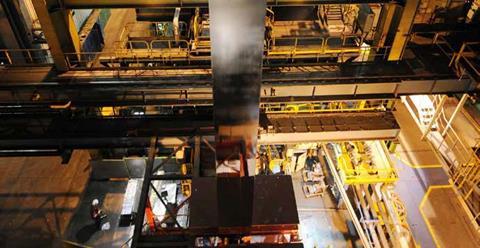With electrification shaping ideas in future vehicle structure design, ArcelorMittal explains why advanced steel grades remain the materials of choice
 While sales of battery electric vehicles (BEV) are still far behind conventional internal combustion engine (ICE) vehicles, BEV technology and sales continue to improve at a rapid pace. Globally, BEV sales exceeded one million units in 2017 compared to just 773,600 in 2016. Global BEV sales are expected to reach two million units in 2018 and account for 25% of all car sales by 2025. While vehicle makeup will look very different in 2025 compared to today, one constant that will remain is the critical role that steel plays in vehicle design.
While sales of battery electric vehicles (BEV) are still far behind conventional internal combustion engine (ICE) vehicles, BEV technology and sales continue to improve at a rapid pace. Globally, BEV sales exceeded one million units in 2017 compared to just 773,600 in 2016. Global BEV sales are expected to reach two million units in 2018 and account for 25% of all car sales by 2025. While vehicle makeup will look very different in 2025 compared to today, one constant that will remain is the critical role that steel plays in vehicle design.
First, to understand where the future of mobility is heading, it’s important to understand what is driving the change. Both North America and the European Union have rolled out stringent emissions targets that aim to reduce CO2 emissions while tightening testing requirements. Furthermore, local governments around the world are looking to implement vehicle design and driving restrictions that will help reduce smog and particulate levels and thereby improve public health. Also, energy dependence on foreign countries will be reduced. Such factors are quickly moving us toward an electrified world for transportation. The most obvious reason for the shift is that BEVs emit no carbon or nitrogen oxides during the drive phase, reducing overall fleet emissions significantly. But, there are many other benefits that appeal to consumers. BEVs have nearly 90% less rotating parts than ICE vehicles, meaning less wear and tear on the car and a lifespan exceeding 600,000 miles.
Regular maintenance of BEVs is significantly lower as they require no oil changes and other tune-ups more common in ICE vehicles. Operating costs per mile are significantly lower in BEVs as compared to ICE vehicles. While the benefits are significant, the financial cost and driving range of BEVs are key in determining how quickly sales will take off. The innovation taking place to improve the range, cost and charging time of batteries has accelerated. In recent months, we’ve seen key announcements from major automakers on their expectation for this field. Volkswagen announced it will spend $40 billion on electrification over the next five years. Meanwhile, General Motors will launch at least 20 new electric vehicles by 2023 and Ford will invest $4.5 billion and introduce 13 electrified models in the next five years. One of the limitations of BEVs is the weight of the battery and the extra reinforcement needed to protect the battery during a crash. A BEV requires greater energy absorption to handle the larger kinetic energies of a heavier vehicle and a stronger roof structure to manage greater roof crush loads.
Balancing strength, mass and performance. Steel offers the optimal balance of strength, performance and mass reduction with the least impact on the environment. Steel is the material of choice for today’s vehicles and will remain the material of choice for vehicles of tomorrow. ArcelorMittal’s advanced steel grades – including our patented press hardenable steel Usibor 2000, MartINsite 1700, and MartINsite 2000 – all offer greater strength per unit density than aluminium. And our Fortiform cold stamping grades offer greater energy absorption per unit density than aluminium.
 In fact, steel’s unmatched strength enhances intrusion resistance while the thinner gauge steel allows for more space in the battery protection system to accommodate larger batteries, thereby increasing driving range. Aside from protection and performance, another focus for automakers is controlling vehicle cost. Increasing battery capacity by just one kilowatt per hour typically costs around $120. Advanced high-strength steels (AHSS) offer the most cost-effective solution to improve battery range without adding in more weight. In fact, steel is the most affordable material over all competing materials.
In fact, steel’s unmatched strength enhances intrusion resistance while the thinner gauge steel allows for more space in the battery protection system to accommodate larger batteries, thereby increasing driving range. Aside from protection and performance, another focus for automakers is controlling vehicle cost. Increasing battery capacity by just one kilowatt per hour typically costs around $120. Advanced high-strength steels (AHSS) offer the most cost-effective solution to improve battery range without adding in more weight. In fact, steel is the most affordable material over all competing materials.
Automakers are also recognising the benefits of steel, with major applications of steel seen in today’s BEVs. As just one example, the body-in-white of the Chevrolet Bolt is composed of 86% steel, including 44% AHSS. Like Chevrolet, OEMs are using the advanced lightweighting potential of steel to achieve their range goals while keeping costs low to improve affordability.
Cleaner and lighter One final yet critical benefit that steel offers can be found in a vehicle’s lifecycle – production phase, drive phase and disposal. In North America, regulations only consider tailpipe emissions generated during the drive phase of a vehicle. However, an ICE vehicle’s production phase comprises nearly 20% of total greenhouse gas (GHG) emissions, and that figure more than doubles to 47% for BEVs. Peer-reviewed and publicly available research shows that aluminium production requires seven times more energy than steel and emits four to five times more GHGs. If we don’t consider production phase emissions when evaluating environmental impact of a vehicle, we may choose a lightweighting material that emits more GHGs during production than it saves during the vehicle’s drive phase.
This will result in a huge and irreversible environmental mistake. Steel offers the optimal balance of strength, performance and mass reduction with the least impact on the environment at the lowest cost. Steel is the material of choice for today’s vehicles and will remain the material of choice for vehicles of tomorrow.


































